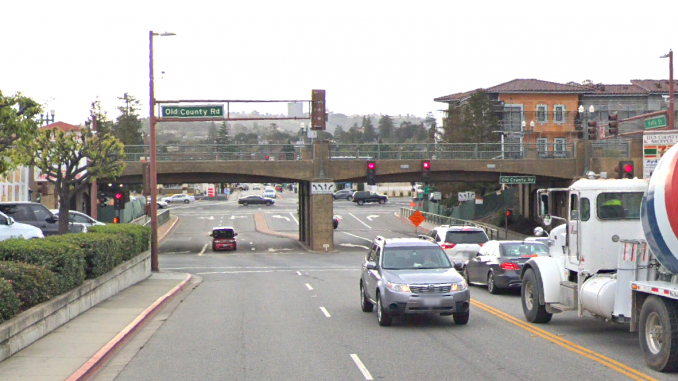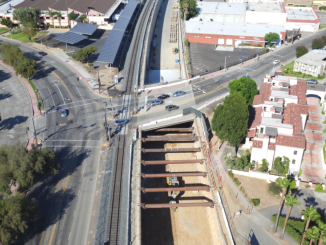
BY ELAINE GOODMAN
Daily Post Correspondent
Just as a Palo Alto community advisory group is finalizing its recommendations on how to separate the street from the Caltrain tracks at three railroad crossings, Caltrain is launching its own two-year study of grade separations along the Peninsula.
The idea behind Caltrain’s study isn’t to tell individual cities what kind of grade separations to build. That decision is an “intensely sensitive community issue,” according to Sebastian Petty, deputy chief of planning at Caltrain.
The study will instead look for ways to reduce costs and construction-related disruptions to Caltrain service as Palo Alto and other cities along the Peninsula pursue grade separation projects. Caltrain might decide in its study what design standards to apply to grade separations, to streamline the review of individual projects.
And with a corridor-wide vision for grade separations, it might be easier to get funding for the projects, which could have a combined cost of billions of dollars, Petty said.
Petty said there’s nothing wrong with cities working on grade separation issues individually. But with each city doing its own planning and seeking funding separately, “on a corridor-wide scale, it’s just not adding up,” he said.
“Because of the governance and the underlying funding, we’re kind of doing these things in the slowest, most expensive way possible,” Petty said.
Petty’s remarks came during a July meeting of Palo Alto’s Expanded Community Advisory Panel, or XCAP. His comments are recapped in a progress report from XCAP for tonight’s City Council meeting.
XCAP is finishing up its recommendations on three railroad crossings in Palo Alto, with a final report to council expected next month. The three crossings are at Churchill Avenue, Meadow Drive and Charleston Road. The crossing at Palo Alto Avenue isn’t being discussed at this time.
XCAP voted 6-3 this month to recommend a closure of Churchill Avenue at the railroad tracks.
The group continues to deliberate over several options for Meadow Drive and Charleston Road. The options include building a viaduct to raise the train tracks above the street; lowering the streets so traffic goes under the tracks; using a hybrid approach of raising the tracks and lowering the streets; or lowering the tracks into a trench.
South Palo Alto tunnel ruled out
XCAP voted unanimously in February against moving the train tracks into a tunnel below the Meadow and Charleston crossings — either with passenger and freight trains both using the tunnel, or with freight trains continuing to use tracks at the surface.
The decision to nix the tunnel was based on the “cost and the complexity of technical issues associated with the alternatives,” XCAP chairwoman Nadia Naik said in the report for tonight’s council meeting.
Petty from Caltrain said he expects the agency’s study to start before the end of this year. During the first six months, Caltrain would talk with cities along the corridor and others to decide what the study should include.
Overall, the study should take about 2½ years to finish, he said.
The Caltrain official noted that as interest in grade separations is growing, their cost and complexity is increasing. That’s due to factors including rising construction costs, the impacts of Caltrain electrification and Caltrain’s positive train control project, or PTC, which is a signaling system meant to improve safety.
Thus far, Petty said, individual grade separation projects haven’t been able to get federal funding and relatively little state funding has been available.
Palo Alto has spent years studying how best to separate car traffic from trains at the crossings in town. The issue has taken on more urgency as Caltrain gets closer to electrifying its trains. The electrified trains are expected to run more frequently, which could lead to traffic jams when the gates come down more often.
At one point, the City Council had planned to choose alternatives for the grade separations in October 2019. The council postponed its decision so that the newly-formed XCAP could study the issue. A final report from XCAP was expected in April, but then delayed because of the COVID-19 pandemic.
COVID-19 has caused Caltrain ridership to drop by as much as 97%. But Naik said in her report that XCAP is confident the region will recover.
“Caltrain will eventually run a high volume of trains again,” the report said. “Although the time horizon has been extended by some amount, traffic congestion and the issue of safety at the grade crossings will return to Palo Alto, necessitating grade separations.”




If 60% of Bay Area workers decide to stay home, as the MTC wants, Caltrain won’t need to expand. These grade separations won’t be needed.
in our country these problems were already changed in the 70’s and 80’s with heavy traffic on roads and railroad lines with conversions on 2 levels. since then there have been no more accidents because some people want to cross the tracks quickly on foot or by bicycle before the train arrives and are then caught and killed by the train. with 2 levels there is no need for rail or road traffic to wait because of the other and both can always drive. so in the long term both profit from every level crossing that is eliminated and traffic on 2 levels can then circulate unobstructed.
such conversions cost money but save many lives in the long run and pollute the air less because nobody has to wait with running engine